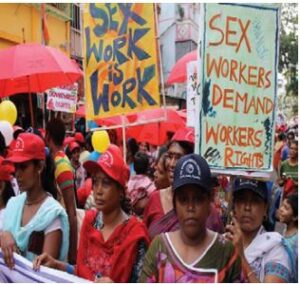
Sanjay Leela Bhansali’s new film Gangubai Kathiawadi raises questions about the rights of the prostitutes that reminds us of a gritty sex worker who decided to organise all sex workers of Kamathipura in Mumbai together and fought for their rights to the respect given to other indigenous workers in the country.
The most powerful statement Rima Kagti makes through her 2012 film Talaash – The Answer Lies Within is the absolute “disempowerment” of a woman who becomes a sex worker. Her “work” identity barely provides her with the bare necessities of life. Once she steps into the trade, she is reduced to a bonded slave. If she is trapped in a police arrest along with other girls, the police staff often force her to sleep with them without paying. So, the sex worker in films or in real life, does not have any power or control over her life/ work/income. There is no dignity in her work, her life and most tragically, in her death.
Chakra (1980) examines life in the raw in actual slum environs. Sex work here is a way of life, a way of earning a livelihood just like wagon- breaking in railway yards is. Amma (Smita Patil) is a woman whose name nobody bothers to find out. She is not exactly a sex worker but sleeps around to survive. Her grownup son coolly moves outside the hut to sleep on a cot and asks no questions. Yet, she pathetically urges her son to live a life of ijjat (respect).
The Census of India has strong issues about the distinction between “workers” and “non-workers.” It lists homemakers, beggars, prisoners and prostitutes as “non-workers” because they are “economically non-productive workers” by definition. The apex court however, does not seem to notice the gender bias in the Census of India’s labelling the prostitute a non-worker and as economically non-productive.
She continues to be marginalised and stigmatised
Around a decade-and-a-half ago, social activists and NGOs toyed with the nomenclature of the prostitute. She is now called a ‘sex worker’ instead of ‘prostitute.’ But the Census did not implement this change so the sex-worker still remains labelled a prostitute. This change in nomenclature probably arose to bring these marginalised and stigmatised women within the mainstream. But this has not happened. It has only vested her with a false sense of self-esteem which she does not possess.
If she is deemed a ‘sex worker’, how does the Census deny her the status of being a productive worker who contributes to the economy directly and indirectly? How did the Supreme Court fail to notice this anomaly while it was hauling the Census for its callous ignorance of the homemaker’s contribution? In Indian law statutes, prostitution is defined as the act of a female who offers her body for promiscuous sexual intercourse for hire, in exchange for money or kind. The two conditions that define a woman as a prostitute according to the Suppression of Immoral Traffic in Women and Girls Act, 1956 (amended in 1987 by the Amendment Act 1986 with the name changed to read “Immoral Traffic (Prevention) Act” and the 2006 Bill are (a) a female has to offer her body for indiscriminate sexual intercourse, and (b) she should do so for some financial consideration. This is the legal definition which clearly spells out that she is a productive worker because her work has both use-value and exchange-value.
Till today, sex work does not have any legal sanction. So, a sex worker has no Aadhaar Card, no Ration Card, no Pan Card and no Voter’s Identity Card. If she is at all given a card, it is linked to some benefit to the Establishment such as a temporary Voter’s Identity Card given just before the elections without the rights such a card ensures. She cannot create a trade union as the profession she belongs to does not recognise sex work as a ‘profession.’ She has no contractual agreement for her work, no pension, no medical and retirement benefits. Nor does she have a birth certificate and rarely if ever, a death certificate. In other words, there is no proof that she exists and therefore, there is no proof of her death.
The ‘illicitness’ of prostituted sex is due to the social disapproval of commercial sex. This brings prostitution within the ambit of the commercialisation of traditional female roles which leads to ambivalence in contemporary economics. When women place monetary value and claim payment for work that they traditionally (within marriage) perform for ‘free’ – out of love, instinct, for intangible non-monetary rewards, it is viewed as ‘betrayal.’ At the same time, when professions get ‘feminised’ in the wage market such as prostitution which is almost a totally feminised occupation, they get devalued. Commercial sex therefore, is nothing more than an inferior version of ‘real’ or free and romantic sex.
A beggar is a parasite, a prostitute is not. A prisoner is a criminal. A prostitute is not. The beggar has neither use-value nor exchange-value. The prisoner has use-value when he is given work in the prison and very little exchange-value for his labour. The prostitute has both. Interestingly, the slippages between women who are prostitutes and sell sex for money and women who are not prostitutes because sex is structured into a married relationship are many in theory, argument and practice.
Sex-worker in India caught in the vicious cycle of poverty
Art historian and author Prof. Lynda Nead argues that the prostitute represents all the terms within capitalist production – she is human labour, she is the object that is being exchanged and she is also the seller.She stands as worker, commodity and capitalist and blurs the categories of bourgeois economics the same way as she tests the boundaries of bourgeois morality. As commodity therefore, the prostitute encapsulates and distorts at the same time, all the classic features of bourgeois economics. This is the full nature of her threat an also the key to her power. (Myths of Sexuality: Representations of Women in Victorian Fiction, 1988) In India, she is human labour and she is the object being exchanged. But she is definitely not the seller. Her earnings are appropriated by the system she belongs to. Does this make her a non-worker?

In India, the supply of women from lower castes into the sex trade is driven by the demand for prostitutes, though prostitution is illegal. Its very existence and pervasiveness in Indian society is an anomaly in an otherwise conservative country. There is a historical culture of commercial sex with eroticism enshrined in the myriad religious tradition such as the Devdasi system in the south and in Odisha. There is greater tolerance of prostitution in rural areas where it is seen as a continuation of a cultural tradition. The large number of pimps, bouncers, self-appointed protectionists within and without the legal machinery, the brothel madams and local politicians form an unending link in a chain of middlemen who cut into the meager earnings of the prostitute, placing her back into the vicious circle of poverty she began from. The circular reality of poverty provides the tragic irony of her existence. Does that make her a non-worker? How can the Supreme Court wear blinkers while chiding the Census for categorising the homemaker as a non-worker and ignoring the same categorisation of the prostitute?
The inhuman oppression of women by civilised mankind is not based on common logic. It is based on the feudal lord’s inherent proprietorial rights over his slave, and on the overwhelming sense of power and control this gives him over the life of his slave. Substitute ‘feudal lord’ with the Census of India, the Supreme Court and the society at large and the ‘slave’ with the sex worker and the argument becomes clear.


 [/column]
[/column]